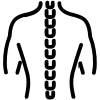Do you spend most of your day sitting at a desk, staring at a computer screen? If so, you aren’t alone. Sedentary lifestyles are one of the greatest challenges of modern existence—they’re both extremely common and dangerous to our health. The good news is that making small changes to your day can help offset the health risks of prolonged physical inactivity.
What Sitting All Day Does to Your Body

Physical inactivity is bad for physical, mental, and emotional health. It increases your risk of developing cardiovascular disease, type 2 diabetes, obesity, and musculoskeletal disorders (MSDs). It can also affect mental health, raising your anxiety and stress levels.
Cardiovascular Health
Physical inactivity is among the top risk factors for cardiovascular conditions. It makes you more likely to suffer from cardiac disease, high blood pressure, and strokes. Remaining in the same position for hours slows down circulation. According to The World Health Organization, low levels of physical activity are at the root of up to 5 million deaths per year globally—proving just how much a sedentary lifestyle can harm us.
Type 2 Diabetes
Sitting for long hours every day also slows down glucose metabolism, which creates imbalances in blood sugar levels. The end result is increased insulin resistance and a higher likelihood of developing diabetes. One study from the University of Leicester in England found that people that spend the majority of their day inactive have a 112% higher risk of type 2 diabetes.
Weight Gain and Obesity
A sedentary lifestyle makes you much more likely to gain weight. A lack of activity slows your metabolism— and since the calories you consume when you eat aren’t burned off by movement, you accumulate fat. More visceral fat means more chronic illnesses, such as obesity. A study led by the CDC showed that the percentage of Americans that are obese rose from around 30% in 2000 to nearly 42% in 2020—a shift related to lower levels of physical activity in people’s daily lives.
Musculoskeletal Disorders
When we sit for a long time, we also often sit with poor posture without realizing it. Hours and hours of sitting improperly can cause stiffness and pain in the back, neck, shoulders, hands, and wrists. Many musculoskeletal disorders (MSDs) are linked to physical inactivity and poor posture. According to a study led by the U.S. Bureau of Labor Statistics, MSDs are the reason for approximately 30% of the sick leave taken in the United States. MSDs are particularly common among people who work at a desk for long hours without breaks and who don’t engage in other regular exercise routines.
Impact on Mental Health
Sedentary lifestyles are as dangerous to our minds as they are to our bodies. Stress, anxiety, and depression are often linked to low levels of physical activity. A study published in Nature in 2024 found that being sedentary long-term is a risk factor for moderate to severe depression. Staying active is important to our quality of life in more ways than one.
Reduced Focus and Productivity
Prolonged physical inactivity diminishes the amount of oxygen that gets carried to your brain, which impacts your cognitive performance. Not only do you have a harder time focusing, but your productivity and your creativity also take a hit. The good news is that it doesn’t take much effort to make a change—this 2023 study proved that being physically active can lead to better focus the very next day!
Lower Quality Sleep
Sleep is yet another victim of a sedentary lifestyle. If you aren’t very active during the day, it becomes much harder for you to fall asleep at night. Low levels of physical activity are strongly linked to sleep problems—and those nights spent tossing and turning have consequences for your physical, mental, and emotional health. The Sleep Foundation explains that physical activity improves your rest in two major ways: it both helps you fall asleep more quickly at night and makes you less likely to feel drowsy during the day.
Tips for Staying Active
Opt for an Ergonomic Chair
One of the simplest ways to combat physical inactivity is switching out a classic desk chair for an ergonomic one. Sitting on a ball seat is the best option, since it doesn’t merely improve your posture, but also encourage “micromovements” like bouncing or rocking—meaning you exercise as you work. Standing desks are also highly beneficial, since they let you alternate between sitting and standing throughout the workday. By combining an ergonomic chair with a standing desk, you can reduce your risk of MSDs, relieve back pain, reduce fatigue, and improve your focus and creativity.
To learn more about how to set up an ergonomic workstation, check out our article.
Move on Your Lunch Breaks
Your lunch break can be a perfect opportunity to stretch your legs. Seize the chance to go for a short walk outdoors, or even just to take a short stroll in the office. In either case, you’ll get your blood moving—improving your circulation and reducing your stress at the same time. You’ll reap the benefits of better focus and productivity for the rest of the day.
If you already have a Bloon ball seat, you can use it for stretching or exercises at your desk. Check out the following articles to learn exercises that you can use with your ergonomic ball seat:
· 10 Easy Ball Seat Exercises to Keep You Active at Work
· 12 Stretches You Can Do at Your Desk to Relieve Stress and Muscle Tension
· How to Work Out at Your Desk Without Anyone Noticing
Try Out “Dynamic Sitting”
Using chairs that encourage micromovements, like ergonomic ball seats and rocking chairs, is known as dynamic sitting. These alternatives to classic chairs require you to use your back and core to stay balanced, helping you strengthen your muscles and sit with better posture throughout the day. Even better, you can say bye bye to the back pain that classic desk chairs often cause.
Take a look at our article about The Bloon Active Seat to learn more about the benefits of dynamic sitting.
Move (Discreetly!) at Your Desk

No gym in your building? No problem. You can squeeze in a workout right from the comfort of your desk with a few discreet but effective stretches and exercises. You also shouldn’t be shy about bringing a few fitness accessories to your workspace. An exercise band and a pair of light ankle weights go a long way!
If you’re looking for easy exercises to do at your desk, we’ve got you covered.
Take the stairs
Taking the stairs instead of the elevator is a great way to get in more physical activity. It strengthens your leg muscles and burns extra calories.
Take Your Meetings on the Go
Why take a meeting at a table when you can take it on a walk? Whether you go outside or just stroll through the office halls, taking your phone calls and meetings on the go doesn’t just help you stay active, it also makes you more creative. Active meetings are gaining popularity in offices worldwide.
Walk or Bike to Work
Start your day off right by walking or biking to work. Beginning your day with movement (and sunlight!) has countlessbenefits for your physical and mental health. If you live somewhere where you have to take a car, park farther down the road or in the back of the parking lot to get more steps in.
Physical inactivity has serious consequences for your health, but there are plenty of ways to get more movement in during the day. Creating a movement-friendly work environment and cultivating simple habits like those described above can help you stay active and healthy lifelong. We recommend incorporating an active seat and a standing desk into your workstation, taking walks on your breaks, holding your meetings on the go, taking the stairs instead of the elevator, and making your daily commute more active. Give these tips a try and see how they change your day for the better!
FAQ: Staying Active at Work
How can I live a more active lifestyle?
Moving more throughout the day is the best way to avoid being sedentary. That movement can take many possible forms—from doing stretches or exercises at your desk, to taking the stairs to your office, to walking on your lunch breaks. We also recommend getting regular exercise, such as by cycling, walking, swimming, or playing sports.
How can I avoid being physically inactive?
We suggest setting up an ergonomic workstation to get more movement into your day. A standing desk gives you the flexibility to shift between standing and sitting, while active seats encourage “dynamic sitting” by stimulating micromovements that keep you active as you work. Try not to spend too much time on your phone or computer outside of work hours, and incorporate regular exercise, like running or swimming, into your weekly routine.
What causes a sedentary lifestyle?
In our modern world, everything is accessible to us with relatively little effort—for example, we get our food from the grocery store, not from farming it ourselves. Most people’s workdays consist almost entirely of sitting in front of screens. Sedentary lifestyles are the result of spending long hours working in a seated position. Hours of sitting, combined with not exercising regularly, is a recipe for health problems. Stress, fatigue, and certain medical conditions can also factor into why people may be sedentary.
Who is most at risk of prolonged physical inactivity and its effects?
The people most at risk are those who work at a desk, since they spend long hours without moving and often have poor posture without realizing it. Children and teenagers that spend a lot of time in front of laptops, cell phones, TV, and tablet screens are also at increased risk. The elderly are a particularly vulnerable group, since certain health conditions associated with aging can limit their ability to move.
Is physical inactivity linked to fatigue?
Physical inactivity can often lead to fatigue, since it slows down metabolism, circulation, and the flow of oxygen in the body. It can also disrupt sleep, which makes you feel even more tired.
What are the potential consequences of being sedentary?
A sedentary lifestyle can increase the risk of developing many kinds of chronic conditions, including cardiovascular disease, type 2 diabetes, obesity, and even certain cancers. It can also cause musculoskeletal disorders, including pain in the back and in the joints, and contribute to mental health troubles like anxiety and depression. Finally, a sedentary lifestyle can diminish your overall quality of life by lowering your energy levels, mobility, and life expectancy.
What are the effects of being physically inactive?
Being physically inactive can cause weight gain, pain in the muscles and joints (especially in the back, neck, and shoulders), chronic fatigue, poor circulation, and poor sleep. It can also worsen your mental health by increasing stress and anxiety and affecting your mood, focus, and motivation.











